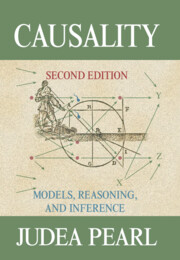Book contents
- Frontmatter
- Dedication
- Contents
- Preface to the First Edition
- Preface to the Second Edition
- 1 Introduction to Probabilities, Graphs, and Causal Models
- 2 A Theory of Inferred Causation
- 3 Causal Diagrams and the Identification of Causal Effects
- 4 Actions, Plans, and Direct Effects
- 5 Causality and Structural Models in Social Science and Economics
- 6 Simpson’s Paradox, Confounding, and Collapsibility
- 7 The Logic of Structure-Based Counterfactuals
- 8 Imperfect Experiments: Bounding Effects and Counterfactuals
- 9 Probability of Causation: Interpretation and Identification
- 10 The Actual Cause
- 11 Reflections, Elaborations, and Discussions with Readers
- Epilogue The Art and Science of Cause and Effect
- Bibliography
- Name Index
- Subject Index
4 - Actions, Plans, and Direct Effects
Published online by Cambridge University Press: 05 March 2013
- Frontmatter
- Dedication
- Contents
- Preface to the First Edition
- Preface to the Second Edition
- 1 Introduction to Probabilities, Graphs, and Causal Models
- 2 A Theory of Inferred Causation
- 3 Causal Diagrams and the Identification of Causal Effects
- 4 Actions, Plans, and Direct Effects
- 5 Causality and Structural Models in Social Science and Economics
- 6 Simpson’s Paradox, Confounding, and Collapsibility
- 7 The Logic of Structure-Based Counterfactuals
- 8 Imperfect Experiments: Bounding Effects and Counterfactuals
- 9 Probability of Causation: Interpretation and Identification
- 10 The Actual Cause
- 11 Reflections, Elaborations, and Discussions with Readers
- Epilogue The Art and Science of Cause and Effect
- Bibliography
- Name Index
- Subject Index
Summary
He whose actions exceed his wisdom, his wisdom shall endure.
Rabbi Hanina ben Dosa (1st century A.D.)Preface
So far, our analysis of causal effects has focused on primitive interventions of the form do(x), which stood for setting the value of variable X to a fixed constant, x, and asking for the effect of this action on the probabilities of some response variables Y. In this chapter we introduce several extensions of this analysis.
First (Section 4.1), we discuss the status of actions vis-à-vis observations in probability theory, decision analysis, and causal modeling, and we advance the thesis that the main role of causal models is to facilitate the evaluation of the effect of novel actions and policies that were unanticipated during the construction of the model.
In Section 4.2 we extend the identification analysis of Chapter 3 to conditional actions of the form “do x if you see z” and stochastic policies of the form “do x with probability p if you see z.” We shall see that the evaluation and identification of these more elaborate interventions can be obtained from the analysis of primitive interventions. In Section 4.3, we use the intervention calculus developed in Chapter 3 to give a graphical characterization of a set of semi-Markovian models for which the causal effect of one variable on another can be identified.
We address in Section 4.4 the problem of evaluating the effect of sequential plans – namely, sequences of time-varying actions (some taken concurrently) designed to produce a certain outcome. We provide a graphical method of estimating the effect of such plans from nonexperimental studies in which some of the actions are influenced by observations and former actions, some observations are influenced by the actions, and some confounding variables are unmeasured. We show that there is substantial advantage to analyzing a plan into its constituent actions rather than treating the set of actions as a single entity.
Finally, in Section 4.5 we address the question of distinguishing direct from indirect effects. We show that direct effects can be identified by the graphical method developed in Section 4.4. An example using alleged sex discrimination in college admission will serve to demonstrate the assumptions needed for proper analysis of direct effects.
- Type
- Chapter
- Information
- CausalityModels, Reasoning, and Inference, pp. 107 - 132Publisher: Cambridge University PressPrint publication year: 2009
- 1
- Cited by



